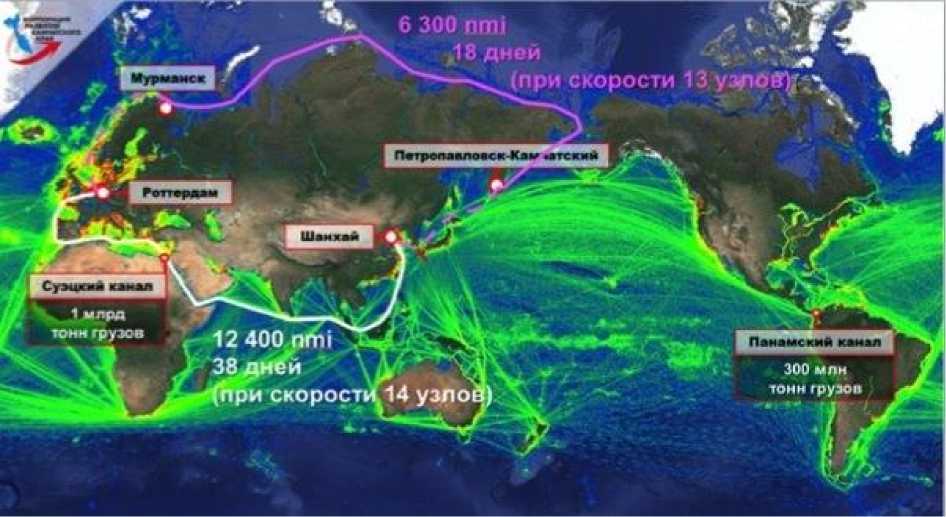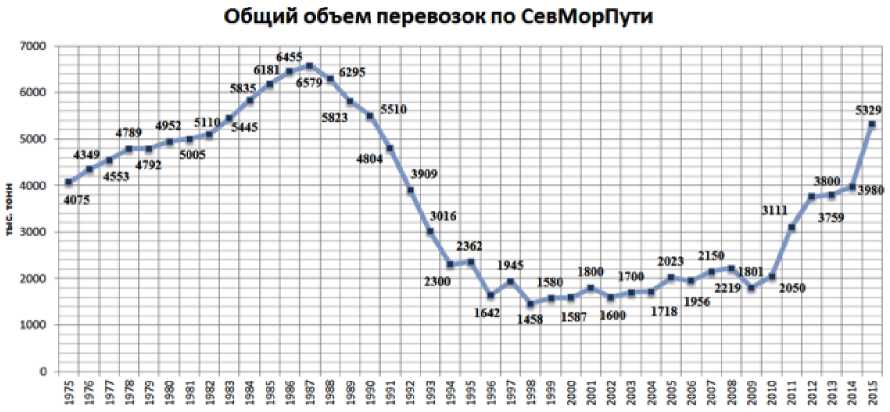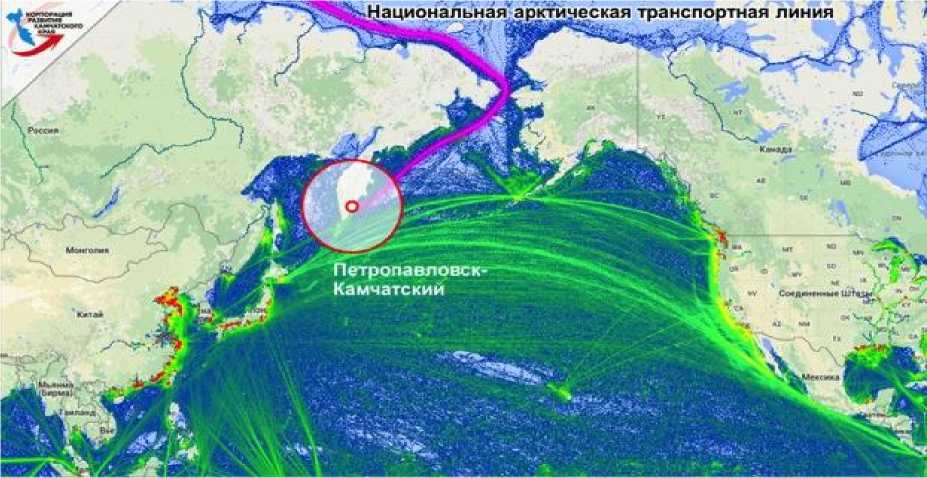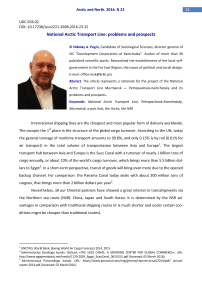National Arctic Transport Line: problems and prospects
Автор: Nikolay A. Pegin
Журнал: Arctic and North @arctic-and-north
Рубрика: Economics, political science, society and culture
Статья в выпуске: 23, 2016 года.
Бесплатный доступ
The article represents a rationale for the project of the National Arctic Transport Line Murmansk — Petropavlovsk-Kamchatsky and its problems and prospects.
National Arctic Transport Line, Petropavlovsk-Kamchatsky, Murmansk, a port hub, the Arctic, the NSR
Короткий адрес: https://sciup.org/148318653
IDR: 148318653 | УДК: 656.02 | DOI: 10.17238/issn2221-2698.2016.23.32
Текст научной статьи National Arctic Transport Line: problems and prospects
International shipping lines are the cheapest and most popular form of delivery worldwide. The occupie the 1st place in the structure of the global cargo turnover. According to the UN, today the general tonnage of maritime transport amounts to 99.8%, and only 0.15% is by rail (0.01% for air transport) in the total volume of transportasion between Asia and Europe1. The largest transport hub between Asia and Europe is the Suez Canal with a turnover of nearly 1 billion tons of cargo annually, or about 10% of the world's cargo turnover, which brings more than 5.5 billion dollars to Egypt2. In a short-term perspective, transit of goods will bring even more due to the opened backup channel. For comparison: the Panama Canal today deals with about 300 million tons of cargoes, that brings more than 2 billion dollars per year3.
Nevertheless, all our Oriental partners have showed a great interest in transshipments via the Northern sea route (NSR): China, Japan and South Korea. It is determined by the NSR advantages in comparison with traditional shipping routes (it is much shorter and under certain conditions mignt be cheaper than traditional routes).
The national Arctic transport line: key issues
The National Arctic Transport Line (NATL), unlike the traditional definition of NSR4, is a broader concept and implies the creation and development of an integrated infrastructure project for the organization of international transport line with specific entry and exit points: Murmansk transport hub in its western part and Petropavlovsk-Kamchatsky transport hub in its eastern part, as well as supporting ports.

Figure 1. National Arctic Transportation Line in a global sea route scheme
The Russian Federation does not actively participate in world trade via traditional sea routes5. Therefore, the NATL might be an instrument of entry to this market by offering its product [1]. The organisation of such a transport line in the Arctic: will integrate the new transport route in international traffic between Asia and the West coast of America and Europe; will contribute to the development of the territories along the NSR; will provide the Russian presence in the Arctic and will open an access to Arctic resources.
Of course, in order to uncover the unique logistical advantages and to create costeffective transport line, there is a need to address a number of key issues:

Figure 2. The NSR transportation volumes6.
-
1) Quality development of ports, logistic, rescue, hydrometeorological and navigation infrastructure.
-
2) A need to develop a single transparent terms of use, security and insurance relevant to international standards, and their control at the national level.
-
3) The availability of icebreakers; competitiveness and transparency of tariffs for icebreaking pilotage. This requires flexible, transparent and unified tariff policy profitable for carriers and competitive with alternative routes’ prices.
-
4) Construction of Arctic container vessels with ice class not lower than Arc7 or new nuclear vessels, capable of transportation of not less than 2000 TEU of cargo, and regular icebreaking pilotage.
-
5) Simplification of getting permissions for shipping.
Publications on this subject note the need to establish a legal and regulatory framework; improvement of servicing the international transport corridor along the NSR (freight terminals, communication centres, etc.); ensuring the NSR the status of as an independent Eurasian transport corridor [2, p. 46, 49].
Some issues have already got emerging plans to address them within the framework of an integrated project for the development of the NSR, approved in June 2015 by The Government of the Russian Federation7. Increase in annual traffic via the NSR up to 80 million tons by the year 2030 8 is an optimistic projection. The main objective set for its development is 17 ports, improvement of navigational, hydrographic and hydrological assistance, and emergency and rescue centers along the
NSR. All this is aimed at ensuring defense issues, as well as the development and construction of marine communication systems. A contribution to the study of scientific and technical problems of the Arctic makes the RAS by implementing a comprehensive program “Search research for the development of the AZRF” and its 100 projects with a total budget of 200 million rubles [3].
In addition, today the AZRF development strategy and national security staretegy untill 2025 are under development. A State Commission for the development of the Arctic is now established. Due to the instructions of the President, Ministry for the development of the Far East ordered a special reserch on development of a competitive NSR model at the Analytical Centre of the Government of the Russian Federation. In accordance with the instructions of D.O. Rogozin from 03.12.2015, the pilot flight of a nuclear lighter carrier “Sevmorput” via the route Murmansk — Petropavlovsk-Kamchatsky might be done this year. The Ministry of Transport is now working on “The Arctic ports development programme” due to the increasing importance of the AZRF. The same way the work of the Arctic and Antarctic Expert Council is being done. It generates proposals for the development of NSR for Far East Development Fund, whose director is the Chairman of the Working Group on the development of the NSR, established by order of the Minister for the development of the Far East.
Despite all of this, one of the key issues, namely the formation of regulatory mechanisms and the selection of a single body responsible for the development of the NSR and the creation of the NATL, remains relevant. The NSR Administration performs primarily as permitting, monitoring and provision of information services. The State Commission on Arctic development is a strategic focal point for interaction of federal bodies of executive power, and other state bodies, local government bodies and organizations in addressing socio-economic and other tasks related to the development of the AZRF and national security9. Integrated development of NSR and the NATL requires a responsible body, which will become a centre of competence and decision-making. There is also a need for certainty on the issue of a single operator or management company or consortium with the assistance of major international transport companies and state corporations. A single operator for these transpirt lines could serve a “single window” for carriers to adress the issues related to cargoes and transportation through the national Arctic routes. Thus, this project should be a joint project of the state and business, where one can invest, use and receive various multiplicative effects.
Securing of transportation along the NATL, port-hubs
This approach is motivated by the fact that international maritime transportation is a business. In order to ensure a truly integrated development of the NATL (NSR) and to attract carriers it is neces- sary to take into account the interests of business, profitability, delivery times, terms of contracts, safety of lines. Carriers are not prepared to assume all the risks of such an infrastructure project. For this purpose, it is necessary to ensure appropriate conditions and safeguards for the carries, so it would be more profitable not to carry cargoes through the Suez or Panama, but send them via the NSR.
Establishment of such lines means consolidation of cargoes at ports-hubs while entering or leavig the Arctic waters and using icebreakers or nuclear carriers. Hubs will play the role of distributor for further feeder transport or overload point for the international transport lines. Shipping containers from other regions could be done with the use of the Arctic container vessels of greater capacity and without icebreakers’ assistance. It will reduce the cost of transportation.
After the launch of the project, availability of infrastructure and organized plans of transportation (transport line), it will be possible to attract new carriers and investors (both Russian and foreign) and to increase cargo flow along the NSR in accordance with the existing plans and projections. The Arctic lines will grow due to the redistribution of cargo flows, especially between Asia and Europe, where traffic is around 19 million TEU. For example, from Japan and Korea to Europe it is more than 1.3 million TEU (7% of the Asian cargoes) and from China more than 8 million TEU (41% of the cargoes to Asia), 50% of these cargoes are going to the Nordic countries10. In the opposite direction — 51% goes from the Nordic countries to China, Korea and Japan [4]. All this potential flows could be made via the NSR in the near future. China says that they are ready to send 15% of cargoes via the NSR in the coming 10-15 years (and this is more than 350 billion dollars). So, here is a cause for optimism. Today China is the most active country using the NSR, after Russia. or the past 5 years, China has sent more than 900 thousand tons of cargo via the NSR11.
Furthermore, ensuring traffic on the NATL s possible due to the development of its own cargo base in the Far East of the Russian Federation. According to the Ministry of Transport, the overall assessment of the commercial base in the Far East could reach more than 200 million tons, i.e. increase by about 50% compared to current levels. In this regard, it is necessary to explore this scenario and to develop transport scheme of cargo delivery via the current transportation system of the region to redistribute this load effectively.
The NATL would not compete the Transsiberian railway, BAM and rail assets to Sakhalin, because their first priority is to solve the transport problems of economic development of the Western and Eastern Siberia. On the contrary, the country will have several strategic transport corridors or interregional links between the West and the East of the Russian Federation. It will reduce the load
of the railways and let them work for better transportation both inside the country and for export (and import) from Urals, Western and Eastern Siberia to Western and Eastern ports.
Today Russia's economic presence in APR is limited to supplies of the raw materials and a certain part of the transit traffic flows between Europe and Asia. Asian countries have an interest to cooperation with Russian companies in various sectors. The Far East can get large infrastructure projects and revitalize the economy of the region and Russia. Thus, in the next decade it will be possible to build international transportation hub connecting traffic flows from South-East Asia, the West coast of North America and Europe through the Arctic transport line based in Murmansk port and Petropavlovsk-Kamchatsky, passing through the Arctic Zone of the Russian Federation. This will give a significant multiplier effect for the development of all related sectors of the economy, increase passenger traffic, and contribute to the creation of new jobs and the modernisation of infrastructure that ensures the safety of navigation.
Seaport hub in Petropavlovsk-Kamchatsky
A key element in the creation of a national Arctic line is the formation of port-hub in Petro-pavlovsk-Kamchatskij. Therefore, it is important to highlight development issues on the Kamchatka peninsula, which plays a special role in a comprehensive project and the NATL. Petropavlovsk-Kamchatsky is a high-latitudinal ice-free port, located in close proximity to international shipping lines from North America to Asia. It is, in fact, the gateway to the Arctic in the North Pacific Ocean. 70% of Canadian goods (which is about 200 million tons) passes a way of 200-300 nautical miles off the coast of Petropavlovsk-Kamchatsky12. In addition to its convenient location, there is a possibility of accumulation, storage, sorting, containerized shipments when delivered without the usual ice-class ships under Russian and foreign flag to Petropavlovsk-Kamchatsky and loading on specialized fleet for further transportation along the NSR.
Thus, as mentioned above, it is possible to realize the idea of feeder transport of so-called “ice shuttles” with higer load and proper ice class. In August 2015, Russian Government decree established the territory of advanced development “Kamchatka”13. According to this document, the key specialization of the territory of advanced development are port industry and tourism. Thus, one of the main platforms of TAD “Kamchatka” is a sea port, which envisages the implementation of projects resulting in the development of port infrastructure and a transit port-hub for stockpiling and sorting of container cargoes during transportation along the NSR, as well as projects promoting Arctic tourism in the region.
Modernization will increase the annual turnover of the port up to 8 million tons14 with the prospect of further increasing to meet growing transport needs of an active development of the Arctic transportation lines.

Picture 3. Petropavlovsk-Kamchatsky and its zone of attraction
The port of Petropavlovsk-Kamchatsky is expected to be a free port15. It will provide additional economic preferences for carriers. Development of Petropavlovsk-kamchatsky port as a part of the NSR and its inclusion into the NATL opens exclusive opportunities for international shipping.
Russia is mostly considered as an exporter of raw materials. Now we have an opportunity to become one of the key players in global trade, production and traffic flows, become the link between global production center (APR) and world centre of consumption (Europe). Establishement of the National Arctic Transportation Line is an important part of the new geopolitical situation in the world.
Список литературы National Arctic Transport Line: problems and prospects
- Zbarashhenko V.S. Strategicheskie transportnye koridory Rossii. Morskie vesti Rossii. 2013, vyp. №5.
- Aleksandrova M. A., Severnyj morskoj put: Osnovnye problemy i perspektivy razvitiya. Infrastrukturnye otrasli ekonomiki: problemy i perspektivy razvitiya 2014. №5
- Nauchno-tekhnicheskie problemy osvoeniya Arktiki. Nauchnaja sessia Obshhego sobraniya chlenov RAN 16.12.2014. Moskva: Nauka, 2015.
- Dr. Chang. Route Planning and Cost Analysis for Travelling through the Arctic Northeast Passage // International Journal of Geographical Information Science. 2015. 12-Mar. P.1—47.


